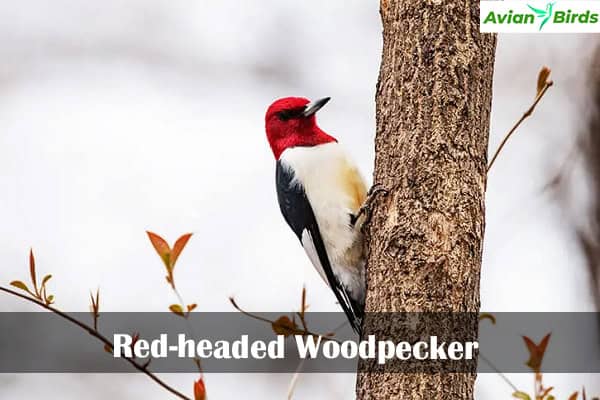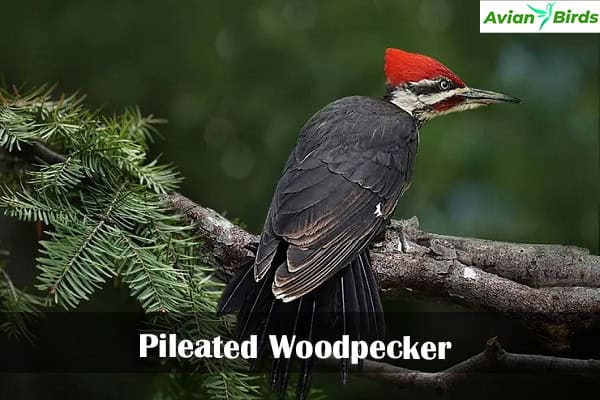Top 10 Types Of Woodpeckers in Michigan (With Pictures)
Ever thought about the variety of Woodpeckers in Michigan? This state is home to nearly half of all woodpeckers in the U.S. You’ll find everything from the bright red-headed woodpecker to the huge pileated woodpecker. Let’s dive into the top 10 woodpecker types found in Michigan’s forests and habitats.
Woodpeckers in Michigan
Michigan is home to a variety of woodpecker species thanks to its diverse ecosystems. These include pine forests, wooded swamps, parks, and gardens. The state’s location, surrounded by the Great Lakes, adds to its rich bird life, hosting nearly 450 species. Woodpeckers are well-suited to Michigan’s landscapes, with their skills in climbing and drilling into wood.
Overview of Michigan’s Diverse Habitats
Michigan’s landscapes are perfect for different woodpecker species. The north has coniferous forests, while the south has deciduous woodlands. Parks, gardens, and wooded swamps add to the variety of habitats. These places help woodpeckers find what they need to live.
1. Red-headed Woodpecker
- Wingspan: 35 – 43 cm
- Length: 19 – 23 cm
- Mass: 56 – 91 g
- Maximum Lifespan: 9 years
The Red-headed Woodpecker (Melanerpes erythrocephalus) is a medium-sized woodpecker found in southern Michigan all year. Northern birds come to the state for winter. It has a bright red head, black back, white belly, and white wing patches. They live in cavities and eat fruits, seeds, and insects, often catching insects in mid-air.

In Michigan, these woodpeckers are seen in many counties. Ionia County has the most sightings, with 4 occurrences in 2021. Crawford County had 3 sightings in 2023. They like open woodlands with tall trees and snags without bark. They live in places like oak forests, floodplain forests, and pine barrens.
| County | Occurrences | Last Observed |
|---|---|---|
| Ionia | 4 | 2021 |
| Crawford | 3 | 2023 |
| Otsego | 2 | 2023 |
| Muskegon | 2 | 2018 |
To help these woodpeckers, we should use prescribed fire and keep barrens open. We should also remove trees that grow too close and keep big snags in logged areas. They breed in Michigan from late May to early July. The best way to find them is by searching or counting them in the morning.
These woodpeckers have lost a lot of their home and food in recent years. They are now quite rare in Oakland County, Michigan. But, they are interesting to watch because they catch insects in the air and store food, making them a unique species in Michigan’s diverse nature.
2. Red-bellied Woodpecker
- Wingspan: 33 – 42 cm
- Length: 23 – 27 cm
- Mass: 56 – 91 g
- Lifespan: >12 years
The Red-bellied Woodpecker (Melanerpes carolinus) is a common bird in Michigan, especially in the south. It’s medium-sized and known for its black-and-white back, buffy-white belly, and visible white rump when flying.

These woodpeckers live in many places, from deep forests to suburban areas. They like both natural and human-made environments. They make their nests in dead trees or parts of living trees.
What they eat changes with the seasons. They enjoy insects, spiders, nuts, seeds, fruits, and more. This variety helps them survive in different habitats.
Red-bellied Woodpeckers show off their looks with different colors. Males have a bright red head, while females have a redneck. Young birds look grayer and don’t have the same redhead colors.
In recent years, these woodpeckers have become more common in some areas. Their numbers are stable or growing, making them a common sight in Michigan.
3. Downy Woodpecker
- Wingspan: 25 – 30 cm
- Length: 14 – 17 cm
- Mass: 21 – 28 g
- Lifespan: >12 years
The Downy Woodpecker (Dryobates pubescens) is the smallest woodpecker in North America. It lives in Michigan all year round. It has a white belly and black back, with white spots on its wings.

It’s smaller than the Hairy Woodpecker, between a sparrow and a robin in size. You can find these birds in many places like woods, yards, and parks. They love to eat from bird feeders, especially suet and sunflower seeds.
During winter, they often join other birds to find food. Males and females have different ways of searching for food. When males are gone, females eat on smaller branches.
The oldest Downy Woodpecker was a male, over 11 years old in 1996. Michigan is home to eight woodpecker species, five of which don’t migrate. The Downy Woodpecker is loved for its curious nature.
4. Hairy Woodpecker
- Wingspan: 33 – 41 cm
- Length: 18 – 26 cm
- Mass: 40 – 95 g
- Lifespan: >16 years
The Hairy Woodpecker (Dryobates villosus) lives in Michigan all year. It looks a lot like the Downy Woodpecker but has a bigger bill and darker tail feathers. You can find these birds in forests, parks, and even in suburban areas. They like to live in dead or dying trees. They eat insects, seeds, and fruits, and visit bird feeders often.

This bird is a bit bigger than the Downy Woodpecker, about the size of a robin. Its bill is as long as its head. Northern Hairy Woodpeckers are bigger than those in the south. Eastern ones have a lot of white on their wings, while Western ones have mostly black wings.
Hairy Woodpeckers spend their time on big tree trunks and branches. They often hang out with Downy Woodpeckers, but they prefer different parts of the tree. They also follow Pileated Woodpeckers to find insects and drink sap from wells made by other birds. Sometimes, they even tap into sugar cane to get sweet juice.
| Characteristic | Description |
|---|---|
| Size | About a third larger than a Downy Woodpecker, roughly robin-sized |
| Bill Length | Almost the same length as its head |
| Regional Variations | Northern birds tend to be larger than southern ones |
| Eastern Subspecies | Extensive white spotting on wings |
| Western Subspecies | Mostly black wings |
| Foraging Behavior | Found along trunks and main branches of large trees |
| Coexistence with Downy Woodpeckers | Downy Woodpeckers use smaller branches, Hairy Woodpeckers use trunks |
| Behavior | Observed following Pileated Woodpeckers, drinking sap, and pecking into sugar cane |
5. Pileated Woodpecker
- Wingspan: 66 – 75 cm
- Length: 40 – 49 cm
- Mass: 250 – 350 g
- Lifespan: >12 years
In Michigan, the Pileated Woodpecker (Dryocopus pileatus) is the biggest woodpecker around. It’s known for its white-striped face and neck, red crest, and black body. This bird is the biggest in Michigan and all of North America.

These woodpeckers are seen all year in most of Michigan, but less in the southeast. They live in old-growth forests with big trees. They make loud calls that can be heard for miles. They use their strong beaks and climbing skills to find carpenter ants and beetle larvae to eat.
The Pileated Woodpecker can have a wingspan of up to 75 cm (30 inches) and be up to 49 cm (19 inches long. They weigh between 250 to 350 grams (8.8 to 12.3 ounces), similar to a crow. Their size and looks make them a favorite among birdwatchers and nature lovers.
Woodpeckers in Backyards and Homes
In Michigan, you might see woodpeckers like the Pileated, Hairy, Downy, and Northern Flicker near your home. They might make some noise during nesting season, from February to June. But remember, they are protected by law, so don’t try to handle them yourself.
There are ways to keep woodpeckers away if they bother you, like using mylar flash tape or taking away their food. If you really need to control them, you can get a special permit from the local DNR office.
Preserving Michigan’s Woodpeckers
- Red-headed woodpeckers in Michigan are medium-sized at 24.1 cm (9.5 in) long, with occurrences ranging from 1 to 4 in various counties.
- Black-backed Woodpeckers in Michigan have a wingspan of 16 inches (40 cm) and a length of 9.5 inches (24 cm).
- Pileated woodpeckers, hairy woodpeckers, downy woodpeckers, and Northern flickers are the main types of woodpeckers found in Michigan.
- Downy woodpeckers are North America’s smallest woodpeckers and the most frequent year-round visitors to backyard bird feeders.
We can help protect Michigan’s woodpeckers by understanding their role in nature. Whether you love birds or just enjoy watching them, seeing Michigan’s woodpeckers is a special treat.
Check Our Previous Articles:
Where to Find Woodpeckers in Michigan
Woodpeckers live in many places in Michigan, like pine forests, wooded swamps, parks, and cities. Great spots to see them include Grand Traverse Commons, Lincoln Brick Park, Old Mission Lighthouse Park, and Sleepy Hollow State Park. These places have the right mix of trees, open areas, and ecosystems for woodpeckers.
Best Locations and Parks for Woodpecker Watching
If you love birdwatching or just want to see woodpeckers, Michigan has great parks and nature spots. Here are some top places for seeing woodpeckers:
- Grand Traverse Commons: This place in Traverse City has trails through pine forests and meadows. It’s perfect for seeing many woodpecker types.
- Lincoln Brick Park: In Lansing, this park has old hardwood trees and wetlands. It’s a great spot for red-headed woodpeckers.
- Old Mission Lighthouse Park: Near Traverse City, this park has woods and fields. It’s where you might see a pileated woodpecker.
- Sleepy Hollow State Park: Close to Lansing, this big park has forests and wetlands. It’s a top spot for birdwatching and seeing woodpeckers.
Don’t forget your binoculars, field guide, and sharp eyes when visiting these spots in Michigan. With patience and luck, you’ll see these amazing birds in their natural setting.
Wrapping Up…
Michigan’s woodpeckers are fascinating birds with unique traits and adaptations. From the red-headed to the black-backed woodpecker, they live in different places. This makes birdwatching in Michigan exciting and rewarding.
These birds are important to the ecosystem. They help with feeding and keeping forests healthy. Whether you’re an expert or new to birdwatching, finding Michigan’s woodpeckers is a great adventure.
By protecting their homes, we help these birds and our natural world. Let’s keep exploring Michigan’s woodlands. Keep an eye out for their sounds and sights. With patience, you’ll enjoy the beauty and variety of Michigan’s woodpeckers.







